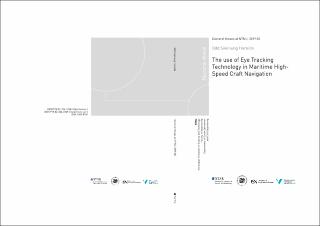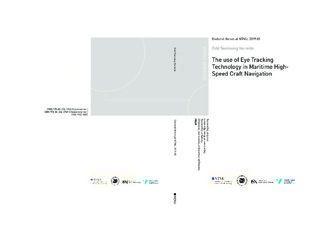| dc.contributor.advisor | Ostnes, Runar | |
| dc.contributor.advisor | Pedersen, Egil | |
| dc.contributor.author | Hareide, Odd Sveinung | |
| dc.date.accessioned | 2019-06-14T12:58:41Z | |
| dc.date.available | 2019-06-14T12:58:41Z | |
| dc.date.issued | 2019 | |
| dc.identifier.isbn | 978-82-326-3769-0 | |
| dc.identifier.issn | 1503-8181 | |
| dc.identifier.uri | http://hdl.handle.net/11250/2600894 | |
| dc.description.abstract | The change from paper charts to Electronic Navigational Charts (ENC) has been regarded as a paradigm shift in maritime navigation. The traditional navigator skills have been challenged with the introduction of integrated navigation systems, but as we have learned from the possibilities and limitations of technology, it has become clear that the craftsmanship of navigation is still needed. There have been discussions regarding the introduction of technology at the ship bridge, and it has become clear that it induces both new possibilities and challenge.
The navigator has always had an important role in conducting safe navigation, and the main job related to navigation has been to find and fix the position to keep the vessel safe. With the introduction of electronic navigation, the vessel’s position is provided in more-or-less real time. The navigator’s role has changed from finding and fixing the position to monitoring the position presented in the navigation system. This has been an important move for the safety at sea, but new challenges such as ECDIS-assisted grounding have emerged. This led to a discussion of the role of the navigator in integrity monitoring of the navigation system, which further demands a certain level of understanding of the sensors and systems in use (system awareness).
The introduction of technology has not only had a positive impact on the navigation task, and the literature reviews highlights that some electronic navigation aids can be inefficient. The literature review also highlights the need for Human-Centred Design (HCD) as a process to design or redesign equipment to the navigator’s needs.
The Royal Norwegian Navy (RNoN) has been pursuing the state of electronic navigation, which primarily means no use of paper charts, since 2014. Along the way, several interesting observations have been made. This mainly involves the trust in the presentation of the position in the navigation system, and the level of system awareness of the navigators. The Navigation Simulators at the RNoN Navigation Competence Centre (NCC) has been increasingly used by the operational crews and in training of the new navigators, and there have been clear indications of the effectiveness of using navigation simulators. Especially the Skjold-Class Bridge Navigation Simulator has been extensively used by the Corvette service, and the feedback has been positive. There has been identified a need for a better understanding of these assertions.
Eye Tracking Technology has rapidly evolved the last ten years, and there has been an increased interest towards the technology within the domain of Human-Computer Interaction. With the introduction of Eye Tracking Glasses (ETGs), data collection of participants’ eye movements has been made possible outside the laboratory. There has not been much use of ETGs in the maritime domain, but in the few studies eye tracking technology has been used; the value of such data has been highlighted. This thesis has used ETGs to better understand the work of the High-Speed Craft (HSC) navigator, by collecting eye tracking data both in field studies and in simulator studies. The aim of the data collection has been to gain a better understanding of the visual attention of the HSC navigator, and to analyse if the eye tracking data can be used in a maritime usability study.
Two different ETGs has been used in the data collection, and the pros and cons of these are presented. Three primary data collections have been completed, and a total of more than 11.5 hours of eye tracking data has been analysed and evaluated. The data analysis has resulted in a deeper knowledge of the visual attention of the HSC navigator, having gained insight into the use of eye tracking data in a design review of the Skjold-class Corvettes.
The visual attention of the HSC navigator has been compared in a field- and simulator study, and there are clear indications of the simulators providing similar training outcome as live navigation training. However, there are differences in the numerosity measurements that needs to be accounted for when designing simulator navigation exercises.
The numerosity measurements and visualizations maps have been used to conduct a maritime usability study of the Skjold-class Corvettes, and the findings and results have been implemented in a Mid-Life Update (MLU) of the navigation bridge of the Corvettes. The eye tracking data analysis shows clear indications of time-stealing displays, and the need for the HSC navigator’s attention to be addressed to the surroundings of the vessel has been highlighted. This resulted in a design review of the bridge layout of the Skjold-Class Corvette, together with a new High-Speed Craft Route Monitor Window (HSCRMW) Graphical User Interface (GUI). The findings from the thesis have been implemented on board the Skjold-class Corvettes, and will be adapted in the RNoN fleet. When validating the new bridge layout and design by collecting the third eye tracking data set, the findings highlights the importance of familiarisation with new software.
Establishment of the Areas of Interest (AOIs) for the HSC Navigator has provided valuable insight into the visual attention of the navigator, and the thesis presents a suggested Scan Pattern for the Maritime Navigator based on these findings. The Navigator’s Situation Awareness (SA) model is presented and discussed, and the importance of system awareness as an inherent part of SA is underlined.
The use of ETGs to collect eye tracking data in maritime HSC navigation to better understand the navigation task of the HSC navigator has shown good potential. When utilizing eye tracking data in maritime usability studies, the importance of supporting data, such as qualitative data, for the eye tracking data is emphasised. The use of the HCD-process in maritime usability studies when utilizing eye tracking data is supported. | nb_NO |
| dc.language.iso | eng | nb_NO |
| dc.publisher | NTNU | nb_NO |
| dc.relation.ispartofseries | Doctoral theses at NTNU;2019:83 | |
| dc.relation.haspart | Paper 1:
Hareide, Odd Sveinung; Ostnes, Runar.
Comparative study of the Skjold-class bridge- and simulator navigation training. European Journal of Navigation 2016 ;Volum 1.(1) | |
| dc.relation.haspart | Paper 2:
Hareide, Odd Sveinung.
Maritime Usability Study with Eye Tracking Data. Kongsberg Digital User Conference 2018;
The Journal of Navigation , Volume 70 , Issue 5 , September 2017 , pp. 927 - 943
https://doi.org/10.1017/S0373463317000182 | |
| dc.relation.haspart | Paper 3:
Hareide, Odd Sveinung; Ostnes, Runar.
Scan Pattern for the Maritime Navigator. TransNav, International Journal on Marine Navigation and Safety of Sea Transportation 2017 ;Volum 11.(1) s. 39-47
https://doi.org/10.12716/1001.11.01.03
Distributed under the terms of the Creative Commons Attribution License (CC BY-NC) | |
| dc.relation.haspart | Paper 4:
Hareide, Odd Sveinung.
Developing a High-speed Route Monitor Window. HCI International 2017
Lecture Notes in Computer Science, vol 10285. Springer, Cham.
https://doi.org/10.1007/978-3-319-58625-0_33 | |
| dc.relation.haspart | Paper 5:
Hareide, Odd Sveinung.
Validation of a Maritime Usability study with Eye Tracking Data. HCI International; 2018
Lecture Notes in Computer Science, vol 10916. Springer, Cham
https://doi.org/10.1007/978-3-319-91467-1_22 | |
| dc.title | The use of Eye Tracking Technology in Maritime High-Speed Craft Navigation | nb_NO |
| dc.type | Doctoral thesis | nb_NO |
| dc.subject.nsi | VDP::Teknologi: 500::Marin teknologi: 580 | nb_NO |

